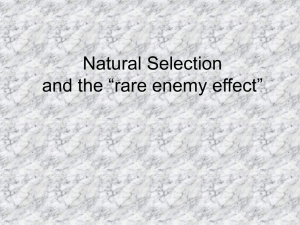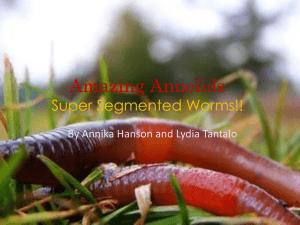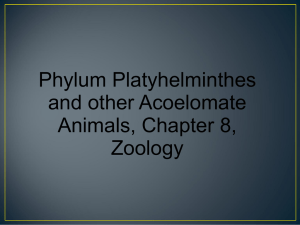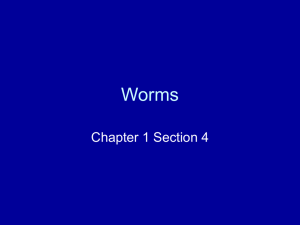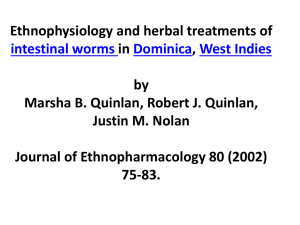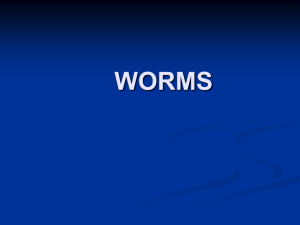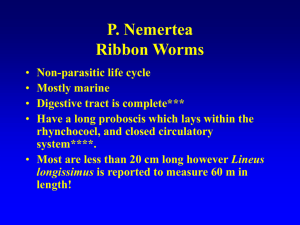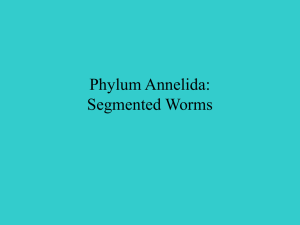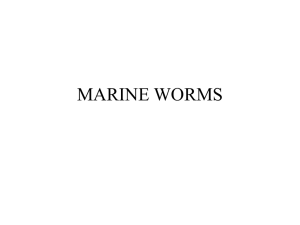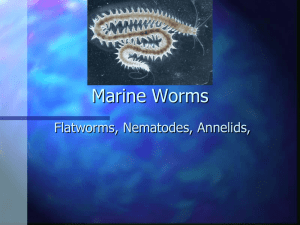worm - Montville.net
advertisement
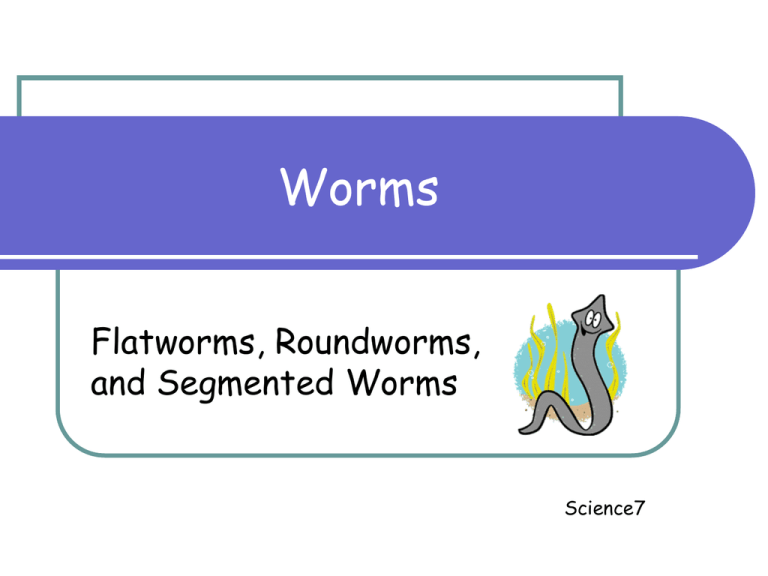
Worms Flatworms, Roundworms, and Segmented Worms Science7 Characteristics of Worms All worms share the following characteristics: Invertebrates Long narrow bodies without legs Tissues, organs, and organ systems (with brain) Bilateral Symmetry (head and tail ends) Reproduction: Sexual and Asexual 3 Cell Layers Ectoderm Mesoderm Endoderm 3 Major Phyla of Worms There are 3 major phyla of worms: Platyhelminthes = Flatworms Nematoda = Roundworms Annelida = Segmented Worms Flatworms From 2 Greek words: Platy means “flat” Helminthe means “worm” Simplest of all worms Flattened bodies Most are parasites and get food from host Flatworms: 3 Types There are many kinds of flatworms: Planarians Tapeworms Flukes Flatworms: Tapeworms Tapeworms Lives in the intestines of animals (including humans!) Uses hooks and suckers on its head to dig into the lining of an organism’s digestive tract Considered Parasitic Blocks the host’s intestines Steals valuable food and water Can grow 10-12 meters in length Life Cycle of A Tapeworm Flatworms: Planarians Planarians Scavengers A feeding tube releases digestive juices to break down food. THINK! – What type of digestion is this? Odor cells are found on the head THINK! – What do the odor cells help with? Planarians have 2 photosynthetic eyespots THINK! – What do the eyespots detect? Watch Planarians :55 Flatworms: Flukes Flukes Usually live in the human liver Shape: Oval and flat Size: 2mm -15 cm Activity: Draw A Flatworm Draw, color, and label the diagram of this flatworm in your guided notes. Digestive Tract (red) Roundworms General Characteristics: Cylindrical bodies Contains a digestive system Food enters at a mouth Waste exits through the anus Roundworms: Trichinella Trichinella Lives in muscular tissue of pigs These worms reproduce in the intestine of the host Female worms release hundreds of immature worms carried in the bloodstream These immature worms burrow in the surrounding tissue causing pain to the host Roundworms: Hookworms Hookworms Enter the body by burrowing through the soles of feet Eventually ends up in the intestines where they live off of blood Roundworms: Pinworms Pinworms Small white parasitic worms found in the feces of babies Babies sometimes ingest microscopic eggs from the soil Activity: Draw A Roundworm Draw, label, and color this diagram of a roundworm in your guided notes. Compare it to a cnidarian which we just learned about. New Guinea Worm: Life Cycle http://www.dhpe.org/infect/guinea.html New Guinea Worm Emerging Video Clip Worms have many unique characteristics different from sponges and cnidarians. Watch this clip: “Three Phyla of Worms_5min 45 sec” Listen for the characteristics that worms were the first to have! Segmented Worms Characteristics Annelida is Latin for “Little Rings” Body is made of many segments An earthworm has more than 100 segments! Organs are found within the segments Segmented Worms: Closed Circulatory System Closed Circulatory System Blood moves within a confined set of blood vessels Five hearts are located in segments 5-13 Segemented Worms: Earthworms How they live They tunnel for a living They are scavengers eating dead plant and animal remains They crawl by using stiff bristles (setae) to pull themselves along Segmented Worms: Earthworms Earthworms and Soil Earthworms make soil more fertile Their tunnels help loosen the soil and allow air, water, and plant roots to move through it. Activity: Draw a Segmented Worm Draw, color, and label this diagram of a segmented worm in your guided notes. Gizzard Crop (setae) Pharynx Esophagus Color Key for Organ Systems Digestive System Circulatory System Nervous System Reproductive System Excretory System Digestive Tract (System) starts in Mouth Pharynx - throat Esophagus – connects throat to crop Crop – storage Gizzard – grinds Intestine – absorbs nutrients Anus Leeches are Segmented Worms NOVA Clip_ Leeches_11min! Leeches can be very helpful worms! Fill out your Ticket Slip as you are viewing.
